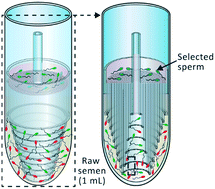Selection of high-quality sperm with thousands of parallel channels†
Abstract
Sperm selection is essential for successful fertilization and embryo development. Current clinical sperm selection methods are labor-intensive and lack the selectivity required to isolate high-quality sperm. Microfluidic sperm selection approaches have shown promise but present a trade-off between the quality and quantity of selected sperm – clinicians demand both. The structure of the female reproductive tract helps to isolate a sufficient quantity of high-quality sperm for fertilization with densely folded epithelium that provides a multitude of longitudinally oriented pathways that guide sperm toward the fertilization site. Here, a three-dimensionally structured sperm selection device is presented that levers this highly parallelized in vivo mechanism for in vitro sperm selection. The device is inserted in a test tube atop 1 mL of raw semen and provides 6500 channels that isolate ∼100 000 high-DNA-integrity sperm for assisted reproduction. In side-by-side clinical testing, the developed approach outperforms the best current clinical methods by improving the DNA integrity of the selected sperm subpopulation up to 95%. Also, the device streamlines clinical workflow, reducing the time required for sperm preparation 3-fold. This single-tube, single-step sperm preparation approach promises to improve both the economics and outcomes of assisted reproduction practices, especially in cases with significant male-factors.



 Please wait while we load your content...
Please wait while we load your content...